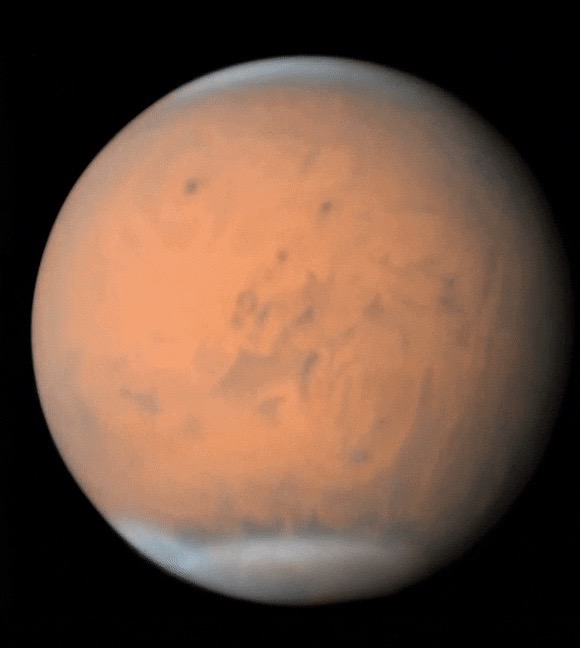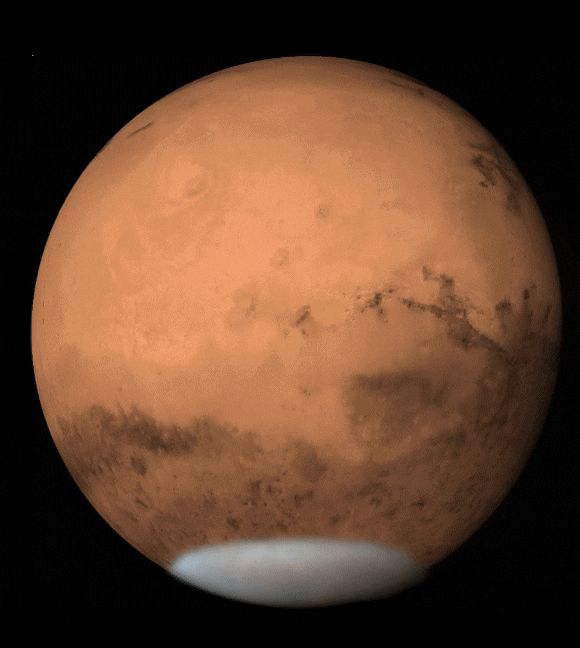
If you have a hard time visualizing a planet-wide dust storm on Mars, take a look at this.
Astrophotographer Damian Peach created an animation showing the dramatic effects of the global dust storm that has plunged the Martian surface deep into darkness.
"The animation was created using my image from June 28th taken from Chile using a 1-meter telescope and the MGS basemap of the exact same longitude," Peach told Space.com via email. (MGS is NASA's Mars Global Surveyor spacecraft, which studied the Red Planet from orbit from 1997 to 2006.) [Mars Dust Storm 2018: How It Grew So Large]
"I carefully matched them together to show a gradual change of the normal clear view of this hemisphere to how it appears now," Peach added. "It shows the large scale-obscuration due to airborne dust." Peach posted the image online via Twitter.
The dust storm began as a localized phenomenon in late May, but it grew incredibly quickly. By the third week of June, the storm had become a planet-circling event, and it continues to rage today. That's a shame for amateur astronomers who had hoped to get a good look at Mars through their telescopes late this month, when the planet makes its closest approach to Earth since 2003.
Currently, the Red Planet's features are "largely lost beneath the dust," Peach said. "It will take at least a couple of months from now for Mars to start to return to a normal appearance — provided further local dust storms do not develop (quite possible as we are now well into the season on Mars where dust events are common)."

The dust storm is also creating issues for NASA's solar-powered Opportunity rover, which has been silent for weeks, unable to recharge its batteries. Opportunity has apparently put itself into a sort of hibernation, turning off everything but its internal clock to conserve energy, mission team members have said.
Get the Space.com Newsletter
Breaking space news, the latest updates on rocket launches, skywatching events and more!
The rover's handlers have expressed optimism that Opportunity will be able to ride out the dust storm, but their anxiety won't clear until the six-wheeled robot finally phones home once again.
The dust storm is a nuisance rather than an existential threat to NASA's other active Mars rover, Curiosity, which is nuclear powered.
Follow Mike Wall on Twitter @michaeldwall and Google+. Follow us @Spacedotcom, Facebook or Google+. Originally published on Space.com.
Join our Space Forums to keep talking space on the latest missions, night sky and more! And if you have a news tip, correction or comment, let us know at: community@space.com.

Michael Wall is a Senior Space Writer with Space.com and joined the team in 2010. He primarily covers exoplanets, spaceflight and military space, but has been known to dabble in the space art beat. His book about the search for alien life, "Out There," was published on Nov. 13, 2018. Before becoming a science writer, Michael worked as a herpetologist and wildlife biologist. He has a Ph.D. in evolutionary biology from the University of Sydney, Australia, a bachelor's degree from the University of Arizona, and a graduate certificate in science writing from the University of California, Santa Cruz. To find out what his latest project is, you can follow Michael on Twitter.









